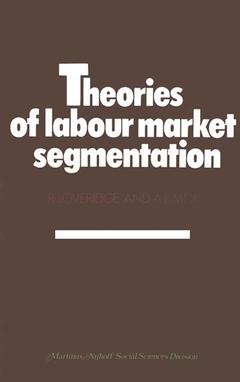Description
Theories of labour market segmentation, Softcover reprint of the original 1st ed. 1979
A critique
Authors: Loveridge Ray, Mok A.L.
Language: English
Approximative price 52.74 €
In Print (Delivery period: 15 days).
Add to cart
Publication date: 02-2012
242 p. · 15.2x22.9 cm · Paperback
242 p. · 15.2x22.9 cm · Paperback
Description
/li>Contents
/li>
The objectives of this book are: to review and develop a framework of key analytical concepts in the field of labour market segmentation; to develop and test these concepts against available data; to indicate weaknesses in the data in the light of the analysis; to offer a critique of manpower policies in some European countries in the light of the foregoing analysis; and to indicate areas of further research. The authors hope that this survey of the literature and the comments that accompany it will prove useful to policy makers and students alike. The authors woulp like to acknowledge the role of the Directorate General for Social Affairs of the European Community, Brussels, in initiating and supporting the production of this volume of criticism and discussion. We have especially appreciated the role of David White, on whose advice we came to rely in directing our critique upon the application of segmental theory to matters of labour market policy. Others whose help and advice we have relied on are John Morley, also of the European Community, Peta Small, who typed the several drafts, and our respective wives and families whose encouragement and discreet silences enabled us to get past the nth draft.
1. Overview of the subject.- The marginal worker as a source of concern.- The marginal worker in theory.- Theories of discrimination-atomistic or structural?.- Empirical evidence of segmentation.- Policy implications of segmentation.- Neo-classical explanations and policy recommendations.- Does the dual market exist in Europe?.- The internal labour market in Europe.- Policy considerations in Europe.- Market strategies among marginal workers.- Some areas for research.- 2. Labour market theories in historical perspective.- Definitions.- The classical and neo-classical labour market.- 3. Segmented labour markets.- Occupational labour markets.- Local labour markets.- Internal and external markets.- The dual labour market.- Conclusions.- 4. Forms of discrimination and their measurement.- The statistical evidence.- 5. The empirical evidence of segmentation.- The crude ‘crowding’ hypothesis.- Differences in patterns of under-employment.- Sources of stigmatism.- The pre-entry (job) discriminatory hypothesis.- The ILM as a source of dynamic?.- The effects of cultural feedback.- The life-cycle hypothesis.- Are the hypotheses proven?.- 6. Labour market stratification and segmentation: some empirical models.- The ‘Munich model’.- The Piore model.- A multi-segmented labour market.- The confrontation of supply and demand.- How viable are the models?.- Cultural capital.- 7. Labour market policy and segmentation.- Labour market policy defined.- Active, inactive and reactive policies.- Conscious andor desired?.- Autonomous?.- The employment service.- Training.- Social security and unemployment benefits.- National minimum wages.- Job creation programmes.- Training, job creation and the internal labour market.- The bureaucratization of policy making.- 8. The labour market as an arena.- Distributive justice and labour market policy.- Competition or conflict?.- Who are the gladiators?.- Interest group formation.- Strategies of aid and enhancement.- The evolution of labour market theory.- Annotated bibliography.- Supplementary bibliography.
© 2024 LAVOISIER S.A.S.




